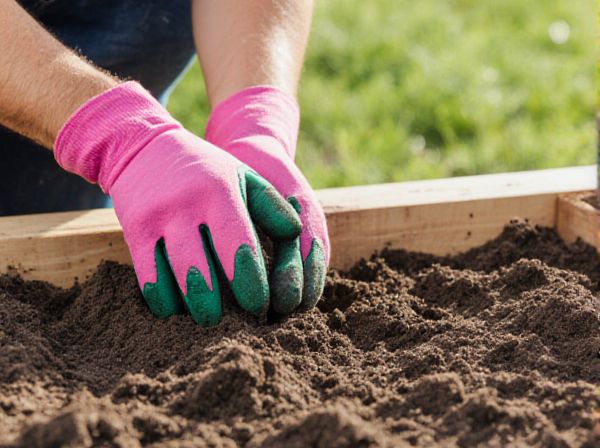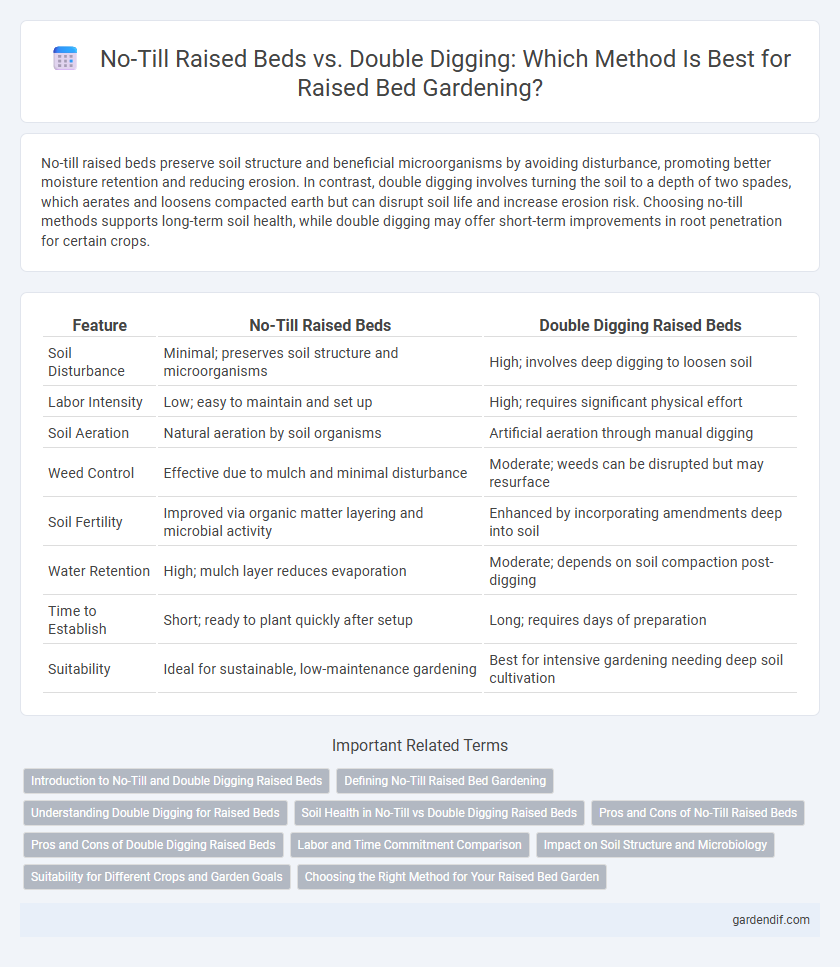
No-till raised beds vs double digging raised beds Illustration
No-till raised beds preserve soil structure and beneficial microorganisms by avoiding disturbance, promoting better moisture retention and reducing erosion. In contrast, double digging involves turning the soil to a depth of two spades, which aerates and loosens compacted earth but can disrupt soil life and increase erosion risk. Choosing no-till methods supports long-term soil health, while double digging may offer short-term improvements in root penetration for certain crops.
Table of Comparison
| Feature | No-Till Raised Beds | Double Digging Raised Beds |
|---|---|---|
| Soil Disturbance | Minimal; preserves soil structure and microorganisms | High; involves deep digging to loosen soil |
| Labor Intensity | Low; easy to maintain and set up | High; requires significant physical effort |
| Soil Aeration | Natural aeration by soil organisms | Artificial aeration through manual digging |
| Weed Control | Effective due to mulch and minimal disturbance | Moderate; weeds can be disrupted but may resurface |
| Soil Fertility | Improved via organic matter layering and microbial activity | Enhanced by incorporating amendments deep into soil |
| Water Retention | High; mulch layer reduces evaporation | Moderate; depends on soil compaction post-digging |
| Time to Establish | Short; ready to plant quickly after setup | Long; requires days of preparation |
| Suitability | Ideal for sustainable, low-maintenance gardening | Best for intensive gardening needing deep soil cultivation |
Introduction to No-Till and Double Digging Raised Beds
No-till raised beds preserve soil structure and microbial life by avoiding soil disturbance, enhancing water retention and reducing erosion. Double digging raised beds improve soil aeration and nutrient mixing by manually loosening two layers of soil to promote root growth. Both methods support sustainable gardening but differ significantly in soil management practices and long-term impacts on soil health.
Defining No-Till Raised Bed Gardening
No-till raised bed gardening involves cultivating soil without disturbing its natural structure, preserving beneficial microorganisms and soil health. This method contrasts with double digging, which requires intensive soil turning to aerate and loosen the ground. No-till raised beds enhance soil moisture retention and reduce erosion while promoting long-term sustainability in garden ecosystems.
Understanding Double Digging for Raised Beds
Double digging raised beds involves manually loosening two layers of soil to improve aeration, drainage, and root penetration, promoting healthier plant growth. This method contrasts with no-till raised beds that avoid soil disturbance to preserve microbial ecosystems and soil structure. Understanding the benefits and labor intensity of double digging helps gardeners decide the best approach for optimizing soil fertility and crop yields in raised bed gardening.
Soil Health in No-Till vs Double Digging Raised Beds
No-till raised beds preserve soil structure, beneficial microbial populations, and organic matter by avoiding disturbance, thus enhancing long-term soil health and reducing erosion risks. In contrast, double digging improves aeration and initial nutrient accessibility but disrupts microbial habitats and accelerates organic matter decomposition, potentially degrading soil quality over time. Maintaining intact soil layers in no-till systems supports sustainable nutrient cycling and promotes resilient soil ecosystems compared to the more invasive double digging approach.
Pros and Cons of No-Till Raised Beds
No-till raised beds preserve soil structure and microbial life by avoiding disturbance, resulting in improved soil health and enhanced carbon sequestration. They reduce labor and fuel consumption compared to double digging, but may face challenges with initial soil aeration and nutrient mixing. Weed control can be more difficult in no-till beds, often necessitating mulching or cover crops to maintain productivity.
Pros and Cons of Double Digging Raised Beds
Double digging raised beds enhance soil aeration and root penetration by loosening deeper soil layers, promoting better drainage and nutrient absorption. This method requires significant physical effort and time, with potential disruption of soil structure and beneficial microorganisms. While it improves immediate soil conditions, double digging may increase erosion risk and is less sustainable compared to no-till methods that preserve soil integrity.
Labor and Time Commitment Comparison
No-till raised beds require significantly less labor and time compared to double digging raised beds, as they avoid the intensive soil disruption and deep turning characteristic of double digging. By preserving soil structure and minimizing physical effort, no-till methods allow for quicker preparation and ongoing maintenance, making them ideal for gardeners with limited time or physical capacity. In contrast, double digging demands extensive manual labor and can take several hours or days depending on bed size, delaying planting schedules.
Impact on Soil Structure and Microbiology
No-till raised beds preserve soil structure by minimizing disturbance, maintaining beneficial microbial communities and promoting natural soil aeration and water retention. Double digging significantly alters soil layers, which can temporarily disrupt microbial habitats and reduce organic matter integrity. Over time, no-till methods enhance soil biology and structure, supporting sustainable plant growth and ecosystem health.
Suitability for Different Crops and Garden Goals
No-till raised beds preserve soil structure and microbial life, making them ideal for crops requiring delicate root systems, such as leafy greens and herbs, while promoting long-term soil health. Double digging raised beds enhance aeration and nutrient availability, suited for root vegetables like carrots and potatoes that benefit from deep, loose soil. Gardeners aiming for sustainability and minimal disturbance often prefer no-till methods, whereas those targeting high-yield root crop production select double digging for its intensive soil preparation.
Choosing the Right Method for Your Raised Bed Garden
No-till raised beds preserve soil structure and microbial life by avoiding disturbance, promoting healthier soil ecosystems and reducing erosion. Double digging raised beds enhance soil aeration and root penetration by loosening compacted soil layers, which improves drainage and nutrient availability. Choosing between no-till and double digging depends on existing soil health, garden goals, and your commitment to ongoing soil maintenance.
No-till raised beds vs double digging raised beds Infographic

 gardendif.com
gardendif.com